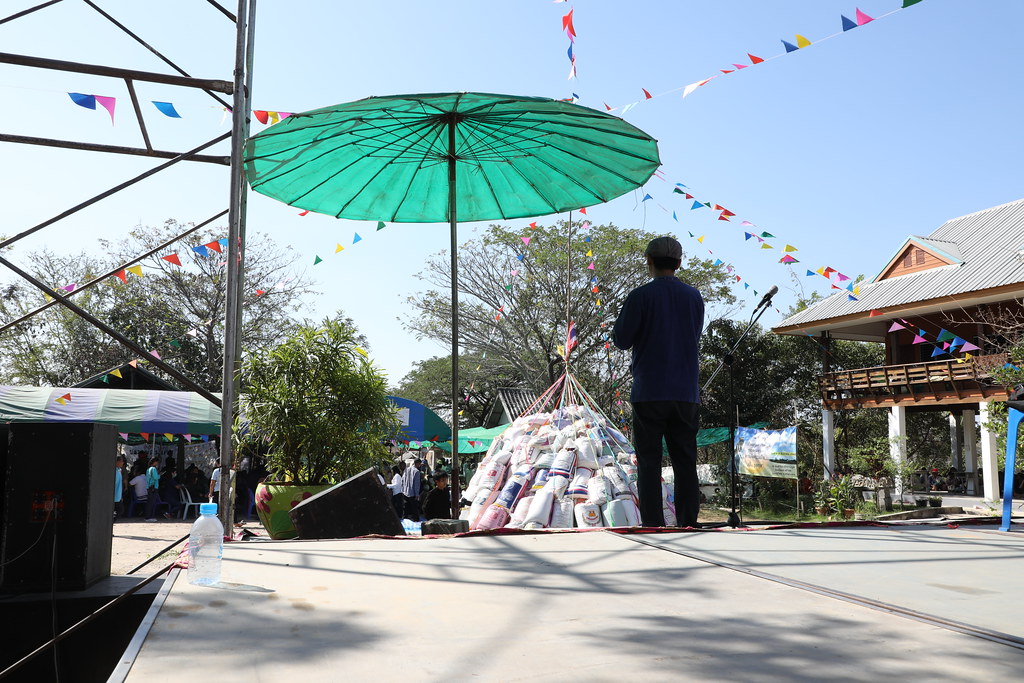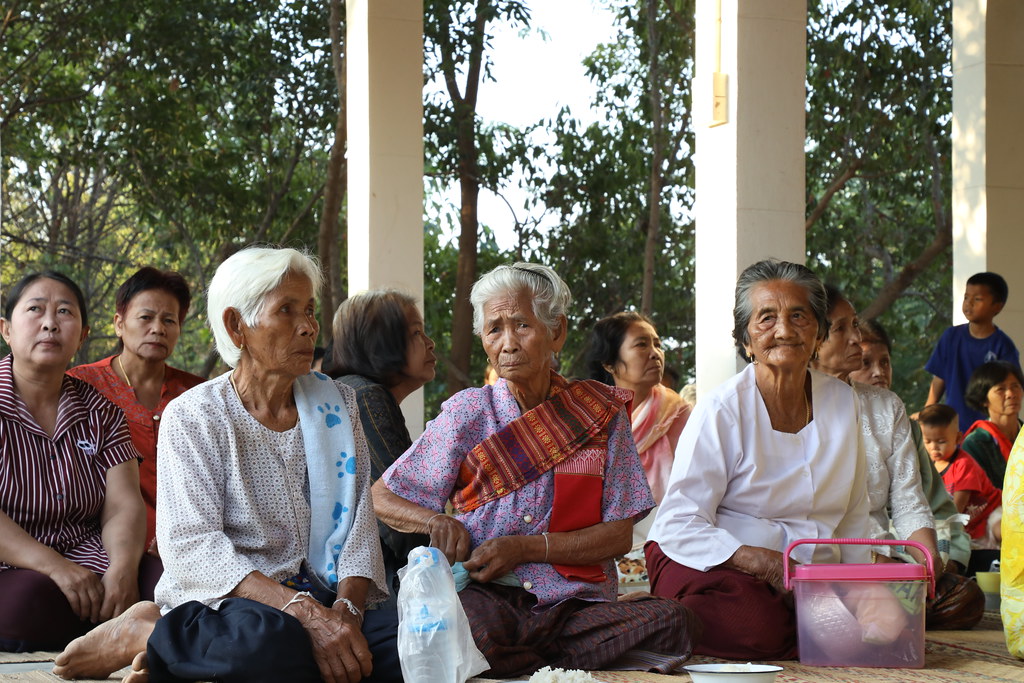Rasi Salai, Sisaket - A twenty-foot high tower of rice sacks presides over The Wetlands Center in Rasi Salai, serving as a reverent centerpiece assembled by local villagers in honor of their land and labor. For a community bound together by the natural world and, increasingly, the myriad of threats to it, the rice mound is a symbol to be admired.

The Rasi Salai Rice Festival (Photo by Brandon Block)
Over 500 people and countless more grains of rice gathered at the Center this weekend, for the official purpose of celebrating rice harvest and paying respect to nature spirits. But conversations here often drift to the other major, life-changing force along this stretch of the Mun River: the Rasi Salai dam.
Rice harvest festivals have historically been held throughout Thailand. But the annual holy day has taken on a new meaning in Rasi Salai, as one way to bring Mun river communities together - and as a creative protest tool cataloging the ways the dam has irreparably altered the river and damaged their way of life.
“Rice ceremony is a way to unite people in this community and make them feel like they belong in a group,” said organizer Ubon Yoowah. Ubon is a two-decade veteran of the Assembly of the Poor, a nationwide organization that emerged in the mid-1990s to advocate for the rural poor in the wake of large-scale international development schemes.
The Assembly of the Poor historically uses collective action as a strategy to engage government officials in negotiations to address massive ecological disruptions such as the Rasi Salai dam.
Since its completion in 1994, the dam has flooded and inundated 50,000 rai of wetlands, straining livelihoods in this overwhelmingly agricultural pocket of the Isaan region. In the three decades since, nearly a dozen activist groups have formed in response. Some use nature festivals as a tool to talk about their degraded homeland, once a fertile source for food and cultural sustenance.

Participants at the festival (Photo by Brandon Block)
“To collect rice from people is also a way to remember what the wetlands used to be,” said Wanpen Saengson, the Assistant Village Head of Dong Dueng village, a few kilometers upstream from the dam. She says crop yields have depleted significantly since the major post-dam flooding.
Wanpen is also a leader in the Rasi Salai Dam Development Group. They organize a separate and less overtly political rice festival than The Wetlands Centers’. While the two groups share the same goals - petitioning the government for compensation and restoration of the wetlands - they have employed different protest strategies over the years.
Three Decades of Protest
Launched by the Thai government in the 1990s, The Khong-Chi-Mun project was a series of 13 planned large-scale dams for the Mun and Mekong rivers partially funded by the World Bank.
The project aimed to improve irrigation, prevent floods, and create jobs.
Scientists particularly were concerned by the government’s failure to conduct any environmental impact studies before approving the dams’ construction.
At the time, former Dean of Khon Kaen University Faculty of Engineering Dr. Prakob Wirojangud said that “the only demand for the project is among politicians and technocrats.”

One of the photos on display at the festival (Photo by Brandon Block)
Unlike other dam projects, the 870 million baht Rasi Salai dam does not generate electricity. Officials from the Ministry of Agriculture originally claimed that the dam would relieve water scarcity and increase farmers’ ability to irrigate land.
Instead, it flooded the land of thousands of farmers, destroying rice fields and livestock habitats. Researchers estimate that as many as 17,000 farmers from three provinces - Si Saket, Surin, and Roi Et - have been negatively affected by the dam, which has contributed to labor migration and breakup of traditional family structures in Isaan.
For years, residents have organized and fought back against the dam in unique ways. In 1997, community members protested the dam’s construction by stealing stones from the dam’s base and orchestrating a mass 25,000 person protest in Bangkok.
In recent years, many of these same community members have organized week-long bike rides along the Mun River, building solidarity amongst dam-affected towns. This strategy, along with The Wetlands Center itself, is a departure from large scale marches in Bangkok. These more subtle forms of organizing draw researchers, activists, and government stakeholders to the dam site, subverting the centralized government regime.
“We built the center because we wanted a place for people to get together and spread knowledge about the wetlands,” Ubon said.
Locating The Center just upstream from the dam itself is part of the activists’ strategy, Ubon explained. Earlier in the day, Ubon and other organizers met with the Vice-Minister of Agriculture Narapat Kaeothong, who briefly visited the rice festival “to pay respect to the rice goddess” - and to talk with dam-affected villagers about a promised compensation payment.
“To go to Bangkok and protest doesn’t work anymore because our members are older,” said Ubon, stroking his wispy white mustache. “With the center, we’ve moved toward building a network of researchers and media people who can help us access the government.”

(Photo by Brandon Block)
At the same time, villagers have taken on their own initiatives to restore their environment, including digging a series of irrigation canals to help regulate seasonal flooding. They’ve also grown model gardens and established a green market where villagers sell their home-grown vegetables.
“Blocking a road may no longer be an effective way to gain attention from the government anymore,” said Dr. Kanokwan Manorom, an Associate Professor at Ubon Ratchathani University and political ecologist who studies natural resource governance in the Mekong region.
Kanokwan is currently part of a team of researchers studying the social, ecological, and economic effects of the Rasi Salai dam with funding from the Royal Irrigation Department. The study was initiated at the behest of concerned villagers.
Kanokwan agreed that as the movement evolves, leaders like Ubon are wise to invest in tactics such as learning centers, that will allow them to sustain critical attention on restoration of the wetlands.
“Knowledge production, entrepreneurial projects, and social media can be more effective means to mobilize young people,” Kanokwan said.
Compensation
Since the dam’s completion in 1994, activist groups have petitioned the government both for financial compensation and wetlands restoration.
As a result of villager’s demands, the government in 1997 began awarding compensation payments to inundated farmers in Rasi Salai. To date, they’ve paid 505 million baht to 5,300 families.
In 2019, Thailand’s military government earmarked an additional 600 million baht in compensation for dam-affected farmers in Rasi Salai, or about 32,000 baht per rai of land.
However, most settlements have excluded people who worked informally on the land or could not produce specific paperwork. It also was split evenly at a flat rate, and so did not address discrepancies in how much land was lost.

Vice-Minister of Agriculture Narapat Kaeothong speaking at the Rice Festival (Photo by Brandon Block)
After meeting with activists and village leaders, Vice-Minister of Agriculture Narapat Kaeothong told Prachatai that the documentation process for distributing the 600 million baht was “almost one hundred percent done” and villagers should see money by July of this year.
While the Ministry of Agriculture offers smaller payments to farmers annually to address increasingly unpredictable seasonal flooding (a phenomenon villagers link to the dam’s construction), Narapat made clear that this money is an acknowledgement of the dam’s historical impact on the community.
“This compensation is for the construction of the dam, because some people lost their land,” Narapat said.
While Narapat admitted the dam has negatively affected farmers, he argued its benefits outweigh the costs. “It’s important to have the dam to store water for dry season,” he said.
To deal with declining rice production, Narapat encouraged farmers who’ve lost land to grow more lucrative, export-oriented crops such as durian.
“People here grow what they’re used to growing, which may not be what the market wants,” Narapat said. “You can change from growing rice to growing something more profitable if you change your mindset.”
“Less land does not mean less income,” Narapat added.
A representative from the Royal Irrigation Department, which took over management of the dam in 2002, also attended the festival.
The Future of Dams
As Royal Irrigation Department officials consider building new dams on the Songkhram, Isaan’s last free-flowing river, Kanokwan urged policy-makers to learn from the mistakes of the past and listen to the residents’ whose lives will be affected.
“The government should do environmental and social impact assessments based on a participatory approach to understand first, whether villagers really need the dam, and then how the dam could potentially damage ecology and livelihoods,” Kanokwan said.


